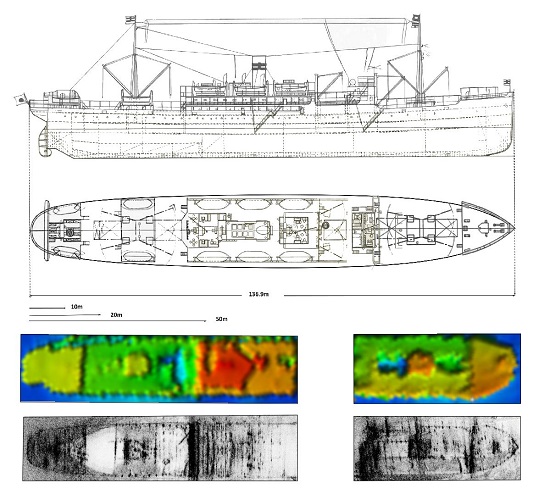
The wreck of the Montevideo Maru.
The shipwreck of Australia’s largest loss of life at sea has been discovered, more than 80 years after it sunk.
The Japanese merchant vessel the SS Montevideo Maru was sunk on 1 July, 1942, off the coast of the Philippines after setting sail from the former Australian territory of New Guinea.
The location of the Japanese transport ship has been an enduring mystery since it was torpedoed by the USS Sturgeon. The submarine’s captain did not know that the ship was carrying approximately 1,060 prisoners from at least 14 countries, including 850 Australian service members from Rabaul. The ship was not marked as a Prisoner of War transport.
Almost twice as many Australians died in this one incident than were killed in the entire Vietnam War. Significantly more were lost than in the sinking of the HMAS Sydney (645) in 1941 and the hospital ship Centaur (268) in 1943.
The search was led by not-for-profit Silentworld Foundation, deep-sea survey specialists Fugro, and supported by the Australian Department of Defence.
The search for the wreck commenced on 6 April in the West Philippine Sea, 110 kilometres north-west of Luzon. After just 12 days, a positive sighting was recorded using state-of-the-art technology, including an autonomous underwater vehicle with in-built sonar.
It took a number of days to verify the wreck using expert analysis from the project team, comprising maritime archaeologists, conservators, operations and research specialists, and ex-naval officers.
At over 4,000m depth, the wreck is deeper than the RMS Titanic.


It took nearly five years of planning by Silentworld and 20 years of dedication from the Montevideo Maru Society to assemble the expedition team, led by Australian businessman, maritime history philanthropist and explorer John Mullen, the director of Silentworld.
“The discovery of the Montevideo Maru closes a terrible chapter in Australian military and maritime history,” Mr Mullen said.
“Families waited years for news of their missing loved ones, before learning of the tragic outcome of the sinking. Some never fully came to accept that their loved ones were among the victims. Today, by finding the vessel, we hope to bring closure to the many families devastated by this terrible disaster.
“I would like to express my gratitude to all of the dedicated Silentworld team involved in this expedition, to the outstanding Fugro crew and technical team on board the Fugro Equator, and to the Australian Department of Defence for their unwavering support.
Chief of the Australian Army, Lieutenant General Simon Stuart, said finding the wreck has ended 81 years of uncertainty for the loved ones of the lost.
“The Australian soldiers, sailors and aviators who had fought to defend Rabaul had enlisted from across the country to serve, met a terrible fate at sea on the Montevideo Maru,” Lieutenant General Stuart said.
“Today we remember their service, and the loss of all those aboard, including the 20 Japanese guards and crew, the Norwegian sailors and the hundreds of civilians from many nations.
“I want to thank the Silentworld team and the dedicated researchers, including the Unrecovered War Casualties team at Army, who have never given up hope of finding the final resting place of the Montevideo Maru.”







